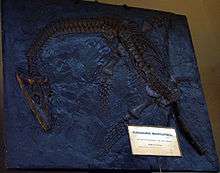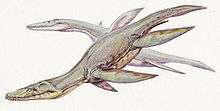Pliosauroidea
| Pliosauroids Temporal range: Hettangian - Cenomanian, 199.6–89.3 Ma | |
|---|---|
 | |
| Rhomaleosaurus cramptoni, Natural History Museum | |
| Scientific classification | |
| Kingdom: | Animalia |
| Phylum: | Chordata |
| Class: | Reptilia |
| Superorder: | †Sauropterygia |
| Order: | †Plesiosauria |
| Clade: | †Neoplesiosauria |
| Suborder: | †Pliosauroidea Welles, 1943 |
| Families and genera | |
|
see text | |
Pliosauroidea is an extinct clade of marine reptiles. Pliosauroids, also commonly known as pliosaurs, are known from the Jurassic and Cretaceous periods. The pliosauroids were short-necked plesiosaurs with large heads and massive toothed jaws. These swimming reptiles were not dinosaurs, but distant cousins of modern turtles. They originally included only members of the family Pliosauridae, of the order Plesiosauria, but several other genera and families are now also included, the number and details of which vary according to the classification used.
The distinguishing characteristics are a short neck and an elongated head, with larger hind flippers compared to the fore flippers, vice versa of the plesiosaurs. They were carnivorous and their long and powerful jaws carried many sharp, conical teeth. Pliosaurs range from 4 to 15 metres and more in length.[1][2] Their prey may have included fish, sharks, ichthyosaurs, dinosaurs and other plesiosaurs.
The largest known species are Kronosaurus and Pliosaurus macromerus; other well known genera include Rhomaleosaurus, Peloneustes, and Macroplata.[3] Fossil specimens have been found in Africa, Australia, China, Europe, North America and South America.
Many very early (from the Early Jurassic and possibly Rhaetian (Latest Triassic)) primitive pliosauroids were very like plesiosauroids in appearance and, indeed, used to be included in the family Plesiosauridae.
Name

Pliosauroidea was named by Welles in 1943. It is adapted from the name of the genus Pliosaurus, which is derived from Greek, πλειων meaning "more/closely" and σαυρος meaning "lizard"; it therefore means "more saurian". The name Pliosaurus was coined in 1841 by Richard Owen, who believed that it represented a link between plesiosauroids and crocodilians (considered a type of "saurian"), particularly due to their crocodile-like teeth.
Classification
Taxonomy
The taxonomy presented here is mainly based on the plesiosaur cladistic analysis proposed by Hilary F. Ketchum and Roger B. J. Benson, 2011 unless otherwise noted.[4]
- Suborder Pliosauroidea
- ? Pachycostasaurus
- ? Sinopliosaurus
- Family Rhomaleosauridae
- Family Pliosauridae
Phylogeny

Pliosauroidea is a stem-based taxon that was defined by Welles as "all taxa more closely related to Pliosaurus brachydeirus than to Plesiosaurus dolichodeirus". Pliosauridae and Rhomaleosauridae are stem-based taxons too. Pliosauridae is defined as "all taxa more closely related to Pliosaurus brachydeirus than to Leptocleidus superstes, Polycotylus latipinnis or Meyerasaurus victor". Rhomaleosauridae is defined as "all taxa more closely related to Meyerasaurus victor than to Leptocleidus superstes, Pliosaurus brachydeirus or Polycotylus latipinnis".[8] The cladogram below follows a 2011 analysis by paleontologists Hilary F. Ketchum and Roger B. J. Benson, and reduced to genera only.[4]
| Pliosauroidea |
| ||||||||||||||||||||||||||||||||||||||||||||||||||||||||||||||||||||||||||||||||||||||||||||||||||||||||||||||||||||||||||||||||||||
| |
Large pliosauroids
In 2002, the discovery of a very large pliosauroid was announced in Mexico. This pliosauroid came to be known as the "Monster of Aramberri". The size of this specimen has been estimated to be about 49 feet (15 meters) long and it had a 10-foot (3 meter) long skull. Consequently, although widely reported as such, it does not belong to the genus Liopleurodon.[10] The remains of this animal, consisting of a partial vertebral column, were dated to the Kimmeridgian of the La Caja Formation.[11] The fossils were found much earlier, in 1985, by a geology student and were at first erroneously attributed to a theropod dinosaur by Hahnel.[12] The remains originally contained part of a rostrum with teeth (now lost).
In August 2006, palaeontologists of the University of Oslo discovered the first remains of a pliosaur on Norwegian soil. The remains were described as "very well preserved, as well as being unique in their completeness". The large animal was determined to be a new species of Pliosaurus.[3] In the summer of 2008, the fossil remains of the huge pliosaur were dug up from the permafrost on Svalbard, a Norwegian island close to the North Pole.[13] The excavation of the find is documented in the 2009 History television special Predator X.
On 26 October 2009, palaeontologists reported the discovery of potentially the largest pliosauroid yet found. Found in cliffs near Weymouth, Dorset, on Britain's Jurassic coast, the fossil had a skull length of 7 feet 10 1/2 inches (2.4 meters) and a body length of 52 feet 6 inches (16 meters). Palaeontologist Richard Forrest told the BBC: "I had heard rumours that something big was turning up. But seeing this thing in the flesh, so to speak, is just jaw dropping. It is simply enormous."[14] The pliosaur was then determined as a new species that scientists named Pliosaurus kevani. In real life, Pliosaurus kevani was nowhere near 16 meters, and was closer to around 10 meters.[15]
References
- ↑ zoom dinosaurs
- ↑ Sea reptile is biggest on record. BBC News, February 27, 2008.
- 1 2 Espen M. Knutsen, Patrick S. Druckenmiller and Jørn H. Hurum (2012). "A new species of Pliosaurus (Sauropterygia: Plesiosauria) from the Middle Volgian of central Spitsbergen, Norway". Norwegian Journal of Geology. 92 (2–3): 235–258. ISSN 0029-196X. Low resolusion pdf High resolusion pdf
- 1 2 Hilary F. Ketchum and Roger B. J. Benson (2011). "A new pliosaurid (Sauropterygia, Plesiosauria) from the Oxford Clay Formation (Middle Jurassic, Callovian) of England: evidence for a gracile, longirostrine grade of Early-Middle Jurassic pliosaurids". Special Papers in Palaeontology. 86: 109–129. doi:10.1111/j.1475-4983.2011.01083.x.
- ↑ Sato, Tamaki; Xiao-Chun Wu (2008). "A new Jurassic pliosaur from Melville Island, Canadian Arctic Archipelago". Canadian Journal of Earth Sciences. 45 (3): 303–320. doi:10.1139/E08-003.
- ↑ Adam S. Smith and Gareth J. Dyke (2008). "The skull of the giant predatory pliosaur Rhomaleosaurus cramptoni: implications for plesiosaur phylogenetics" (PDF). Naturwissenschaften. 95 (10): 975–980. doi:10.1007/s00114-008-0402-z. PMID 18523747.
- ↑ Gasparini, Zulma (2009). "A New Oxfordian Pliosaurid (Plesiosauria, Pliosauridae) in the Caribbean Seaway" (pdf). Palaeontology. 52 (3): 661–669. doi:10.1111/j.1475-4983.2009.00871.x.
- ↑ Ketchum, H.F.; Benson, R.B.J. (2010). "Global interrelationships of Plesiosauria (Reptilia, Sauropterygia) and the pivotal role of taxon sampling in determining the outcome of phylogenetic analyses". Biological Reviews of the Cambridge Philosophical Society. 85 (2): 361–392. doi:10.1111/j.1469-185X.2009.00107.x. PMID 20002391.
- ↑ Schumacher, B. A.; Carpenter, K.; Everhart, M. J. (2013). "A new Cretaceous Pliosaurid (Reptilia, Plesiosauria) from the Carlile Shale (middle Turonian) of Russell County, Kansas". Journal of Vertebrate Paleontology. 33 (3): 613–628. doi:10.1080/02724634.2013.722576.
- ↑ http://www.plesiosaur.com/plesiosaurs/liopleurodon.php
- ↑ M.-C. Buchy, E. Frey, W. Stinnesbeck, J.-G. Lopez-Oliva (2003) "First occurrence of a gigantic pliosaurid plesiosaur in the late Jurassic (Kimmeridgian) of Mexico", Bull. Soc. geol. Fr., 174(3), pp. 271-278
- ↑ Hahnel W. (1988) "Hallazgo de restos de dinosaurio en Aramberri, N.L., Mexico",Actas Fac. Cienc. Tierra UANL Linares, 3, 245-250.
- ↑ Fox News: Predator X Was Most Fearsome Animal to Swim Oceans
- ↑ Morelle, Rebecca (27 October 2009). "Colossal 'sea monster' unearthed". BBC News.
- ↑ http://journals.plos.org/plosone/article?id=10.1371/journal.pone.0065989
External links
- The Plesiosaur Directory - pliosaur page
- Large pliosaur from the Jurassic Coast, Dorset - BBC News
- Dorset pliosaur skull after conservation - video. BBC July 2011



